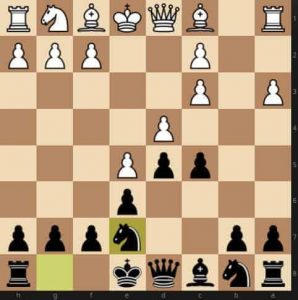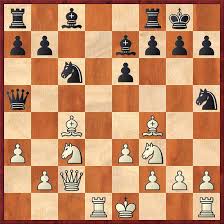A few months ago I recorded a podcast episode with Business Coach Sharon Richter. One of the main topics we covered was how in business and in chess, you always need to know the rules of the game. We were not talking about about rules like “the bishop moves diagonally as far it wants” or “you need to file your taxes once per year”. To the contrary, we meant that every few moves or days, you need to re-evaluate your position and figure out what the best plan is. On the chess board, if one has a worst position, he should seek complications and if he has a better one, he should try to maintain the status quo. In order to evaluate a position and figure out who has a better position, how much, and why, one could follow my former coach, teammate and podcast guest National Master Alan Kantor‘s magical seven steps:
- Material : Who has more pieces on the board? Add up all the points. Assign a color an extra 1/2 point if he has the bishop pair versus his opponent’s knight and bishop or two knights.
- Pawn Structure : Look for items like doubled pawns, isolated pawns, pawn islands, holes, etc.
- Development: Who has more active pieces?
- King Safety : Is one side castled and the other not? Who has a safer king?
- Center : Does either side have a pawn in the center? Who controls it better?
- Space :Who has more freedom to maneuver his pieces? For instance in the French Defense, black often faces a big space disadvantage as his light squared bishop is stuck on c8.

- Attack/Initiative : Who is attacking? Who has more threats than his opponent?
When evaluating the position it is important to consider each step individually and then come up with the overall assessment.
Let’s look at a sample position:

Here is how the evaluate all seven steps:
1) Material: =
2)Pawn Structure: =
3)Development: += (White is slightly better because white has one more minor piece developed and black’s knight on h5 on the side of the board)
4)Center: =
5)Space: += (White has a substantial advantage in space as black has a French-like bad bishop on c8.)
6)King Safety: =+ (Black is slightly better because he is castled and white’s king is still in the center. While white is one move away from castling and that may change, it is important to evaluate the position right now. As he castles, he may lose slight advantage on development).
7) Attack/ Initiative: =+ (Black has a slight initiative as he is threatening to play Nxf4 and double white’s pawns.
Overall, the position is equal as white’s advantage in development and space, balances out black’s slight initiative and lead in king safety. White will quickly castle and try to orchestrate an attack on h7. He will likely retreat his bishop to d3 to create a battery. Black will try to get in an e5 break to open up space for his bishop.
In every game you play moving forward, make sure to evaluate the position as the opening transitions into the middlegame and every 3-4 moves thereafter. Use these steps and you will have a decent idea on what is happening in the positioning and be able to come up with a good plan.


This is great and simple. I feel it adds another level to my game, so thanks for posting.
I think the seven steps are from the book
[Find the Right Plan With Anatoly Karpov ; Anatoly Karpov and Anatoly Mazukevich; Batsford Ltd (1. Juni 2010)]. Which is the translation of a russian book from the mid-80s.
As a 2000 chess.com player, I agree with this as I do it in my chess games. This was helpful and I would like to see more players see this document
Get the VIP treatment you deserve with our exclusive rewards program for loyal players.
Play exciting card games against real dealers!
Thanks for sharing this great instruction. I appreciate it and <a href="[Link deleted]dash lite which is excellent.
Het idee om regelmatig je positie opnieuw te evalueren, zowel in schaken als in het dagelijks leven, spreekt me erg aan. Soms zit je in een lastige situatie en moet je creatieve oplossingen zoeken, terwijl het in andere momenten vooral gaat om je voorsprong behouden. Na een lange dag met zulke mentale oefeningen vind ik het fijn om even te ontspannen op billionairespin, waar spelers uit België speciale bonussen krijgen. Het helpt me om mijn hoofd leeg te maken en weer op te laden.
GemGamer Studio did a great job with Snow Rider 3D.
Their proven track record and expert knowledge make them a dependable choice for anyone seeking excellence.구글찌라시 Their thorough knowledge and commitment to best practices guarantee a smooth and successful experience.
A few months ago I recorded a podcast episode with Business Coach Sharon Richter. One of the main topics we covered was how in business and in chess, you always need to know the rules of the game.